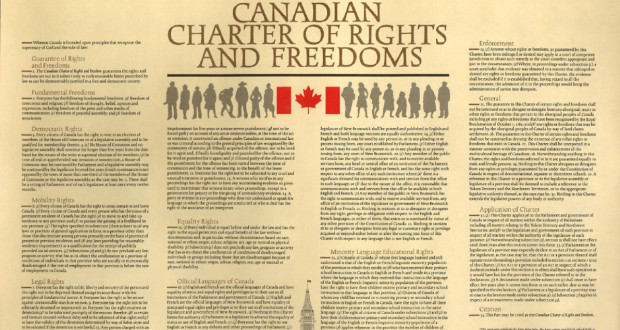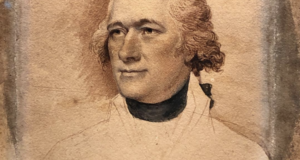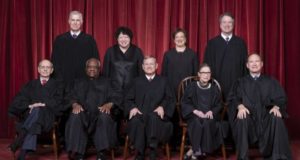Originalism posits that the content of a constitution is determined partly by the intentions and purposes of its founders and the understandings of the founding generation. This essay calls for the (re)introduction of originalism, which has an important place in American politics, legal academia, and courts,1 into Canadian constitutional law. First, I explain the importance of the methodology of constitutional (particularly Charter2) interpretation. Second, I examine the “living tree” doctrine of Charter interpretation and its weaknesses. Third, I defend originalism as a legitimate and robust competing interpretive approach. Finally, I suggest that originalism might serve to enhance democratic participation in constitutional lawmaking in Canada.
Interpretive methodology matters
Constitutional provisions, particularly those that are imprecise, require that judges make them practically meaningful through interpretation.3 In so doing, however, judges risk going “beyond constitutional enforcement to constitutional creation.”4 The question becomes how to distinguish legitimate interpretation from illegitimate constitutional creation or change.5 Illegitimate change occurs when judges usurp the amending function, which Canada’s Constitution Act, 1982 assigns to the legislative branch.6 Where courts draw this line depends on their interpretive methodology,7 which is crucial partly because our courts are rarely subject to review by other institutions.8 Legislatures can alter common law rules through legislation, but judicial misinterpretation of the constitution is much more difficult to correct.
Since the adoption of the Charter, a non-originalist or “living tree” interpretive methodology has so monopolized constitutional interpretation in Canada that originalism is presumed to be precluded as an interpretive approach.9 Consequently, leading originalist scholarship is largely ignored in Canada and the “living tree” doctrine remains underdeveloped.10 Conversely, the United States, whose “living constitutionalism” of the 1960s and 1970s had a major impact on the Canadian judiciary’s interpretive approach to the Charter, is home to a lively scholarly, judicial, and public debate on the subject.11 More significant, however, is the absence of any concrete limits on courts’ Charter interpretations. Even acknowledging, as originalists do, that courts must creatively “fill gaps” in broadly worded provisions, without a robust methodology we cannot decipher when a court has shifted from interpretation to construction.12
A closer look at Canada’s “living tree” paradigm
Goldsworthy suggests, in a comparative study of six countries, that the Supreme Court of Canada (SCC) has, in the Charter era, been the most activist high court in terms of rejecting the idea that it is bound by the intent of the drafters or the text of the constitution as originally understood.13 In early Charter jurisprudence, the SCC extracted the “living tree” metaphor from the 1929 Persons Case and made it the “constitutional bedrock” for Charter interpretation.14 The Judicial Committee of the Privy Council’s (JCPC) ruling in the Persons Case is commonly understood to have rejected originalist interpretation as a doctrine that risks binding communities to past injustices.15 It is true that the JCPC, in its judgment overruling the SCC’s decision that “persons” in s. 2416 the BNA Act did not include women, derided the SCC for its “appeal to history” and “narrow and technical” methodology. However, the notion that the JCPC therein established the “living tree” methodology employed in the Charter era is dubious.17 Miller contends that the JCPC’s reasons in the Persons Case are in fact best aligned with originalism—not in the narrow sense of the framers’ intent, but an originalism that emphasizes original public meaning.18 Miller explains the difference and, importantly, the similarity between the SCC’s and JCPC’s reasoning in that case.
The originalism on display in the SCC’s reasons was an “original intentions originalism” that applied the supposed “original expected application” to resolve ambiguity in semantic meaning.19 The SCC reasoned as follows: the use of the word “persons” in the BNA Act must be given the meaning that it would have had when the Act was passed; however, the meaning of the word “persons” in ordinary use was ambiguous; in light of this ambiguity, the Court must give effect to how the framers believed s. 24 should be applied, that is, whether they would have believed s. 24 authorized the appointment of women.20 The SCC took the fact that no woman had ever been appointed as evidence of a belief that women should not be appointed. This application meaning was also supported, in the Court’s view, by an interpretive presumption that the legislature is aware of the common law (which excluded women at that time) and only overrides such a presumption with express statutory language.21
The JCPC also believed that the meaning of persons was fixed and was “thoroughly textualist” in its methodology, Miller claims.22 It aimed to discover the meaning of “persons” in the Act, not to confer new meaning.23 The JCPC first sidelined “external evidence” as to what “persons” meant.24 Then it looked to “internal evidence” from the BNA Act, noting that other sections of the Act use “person” to include both sexes while others use “male person” or “male British subject”. The JCPC stated that the question is “not what may be supposed to have been intended, but what has been said”; how meaning is fixed was the point of departure.25
What then of the JCPC’s famous statement: “The [BNA] Act planted in Canada a living tree capable of growth and expansion within its natural limits”? The statement was made, Miller explains, in an effort to minimize the controlling effect of English common law in Canada.26 It was English common law that had in part determined the SCC’s ruling. Moreover, Miller points out that the JCPC did not say that the Act is a living tree, but that it planted a living tree—the Canadian Constitution in its entirety, a “Constitution similar in principle to that of the United Kingdom”, including unwritten conventions as well as statutes. The living tree is not the specific textual provisions of the BNA Act. For the JCPC, the task of interpretation was to recover the fixed, semantic meaning of the text. Accordingly, the modern reading of the Persons Case cannot be maintained.27
The American judiciary’s living constitutionalism of the late 20th century also had a major impact in shaping the SCC’s non-originalist approach to the Charter. The US experience preceded and closely paralleled what followed in Canada. Activist American courts extricated a statement from US Chief Justice John Marshall in McCulloch v Maryland (1819) to the effect that the meaning of constitutional phrases should be deduced from the ‘nature’ of the Constitution’s ‘important objects’ in order to take a liberal purposive approach.28 Manfredi claims that the US judiciary had largely abandoned the more cautious elements of Marshall’s interpretive principles by the late 20th century and with a constitutional bill of rights the SCC soon followed suit, selectively referencing both the Persons Case and McCulloch.29 The SCC, without serious reflection, adopted American non-originalism at a time when this approach was being subjected to fierce critiques and questions about its legitimacy.
Originalism—overcoming caricatures
It is generally acknowledged by originalists that the reactionary response in the US during the 1980s to the judicial activism of the previous two decades overemphasized original intent. More sophisticated originalist critiques also emerged during that time, however, and have been further developed since—critiques that get to the heart of the problem with non-originalism as an interpretive paradigm. “After some missteps,” which involved problems with identifying whose intentions counted and what they in fact were, Tushnet writes of the originalist response in America to activist courts, “the jurisprudence of original understanding eventually settled on the proposition that the Constitution’s terms should be interpreted by giving them the meaning they had among the general public at the time they were inserted into the Constitution.”30 Non-originalism, by contrast, treats these considerations as irrelevant or of little weight, licensing judges to interpret the constitutional text according to the supposed underlying purpose and values of contemporary society as the judges see them.31
Jeffrey Goldsworthy summarizes what he considers to be the best argument for originalism.32 First, a constitution, like any other law, necessarily has a meaning.33 Second, its meaning is part or perhaps all of what it is and to change its meaning is to change the law. Third, the original meaning of a constitution is not its literal meaning or its originally intended meaning, but its “utterance meaning”.34 Fourth, the amendment procedure set out in a constitution binds judges as well as other officials and, fifth, to violate this rule is to violate the constitution itself. Sixth, the judges’ primary duty in interpreting a constitution is to reveal and clarify its pre-existing meaning; their secondary duty is, when that meaning is insufficiently determinate to resolve the case, to act creatively and supplement it.35
Peter Hogg observes that in applying the Charter, the SCC has not adhered to those “counsels of restraint Alexander Bickel famously described as the ‘passive virtues’.”36 However, Hogg does not tie the Court’s activist turn to a change in interpretive method. Rather, he suggests continuity since 1929. “Originalism has never enjoyed any significant support in Canada,” he claims. Hogg offers as a supporting argument: “[T]he Privy Council [in the Persons Case] was so indifferent to the original understanding that they refused even to look at any evidence of the intentions of the framers.”37 This “indifference to original understanding,” Hogg continues, “lingers on in the modern Supreme Court of Canada.”38 Reviewing federalism cases, Hogg seems to assume that the flexibility required to assign regulatory power over new industries and human activities through existing heads of provincial and federal powers is not permitted by originalism.39 Miller replies that this kind of flexibility is widely accepted by originalists.40 Miller also points out that changes to interpretations of bills of rights often rest on a different footing than federalism cases, not fitting societal changes into a prescribed structure, but changing moral judgments that have hitherto been institutionalized through legislation.41
Hogg continues by citing early Charter cases in which the SCC gave little to no weight to original understandings. For example, in Dickson C.J.’s reasoning in Hunter v Southam (1984), the Charter was drafted “with an eye to the future” and, because it is not easily amended, “it must be capable of growth and development over time”.42 Originalists agree that many constitutional provisions are broadly worded for this very purpose. But allowing flexibility to address new situations is a different thing entirely from deliberately changing the constitution’s meaning in situations which the framers—and the enactors who voted for the carefully selected text—actually anticipated, as the SCC did in the Motor Vehicle Act Reference (1985).43
Originalism, the rule of law, and democratic governance
“As [originalism and non-originalism] are purged of their weaknesses,” Goldsworthy suggests, “they are moderated and eventually merge.”44 Goldsworthy argues that a sensible originalism fits the “living tree” metaphor because it permits adaptation, while also satisfying the requirements of the rule of law. That competing perspectives are strengthened through critique and refinement is easy to accept. Constitutional law scholarship in Canada could certainly benefit from the competing perspective of originalism. But are there real benefits to be gained in terms of the rule of law and democratic governance?
The American experience would appear to be a powerful rebuke to the argument that originalism can provide a check on and promote consistency and transparency in judicial review. Tushnet says of US jurisprudence, “Some version of a jurisprudence of original understanding remains an essential component of nearly all particular resolutions of interpretive controversies,” yet he nevertheless concludes there is no effective doctrinal constraint on the courts. Judges are in any case free to select an approach that achieves their desired outcome.45 Miller does not address this significant hurdle to originalism being of any real practical benefit. In closing, I attempt to do so.
Those who believe courts can and do “get it wrong” and that there ought to be a check on judicial power can find no recourse in American law—short of, perhaps, constitutional amendment.46 Canada, however, has a tradition of Parliamentary sovereignty that was (partially) preserved through the notwithstanding clause.47 This clause offers the possibility, lacking in the US, of an ongoing check on judicial power. However, the notwithstanding clause’s wording is such that it envisions an override of the Charter, not an avenue through which the legislature may offer an alternative Charter interpretation. Nevertheless, competing interpretive perspectives could be invoked by legislatures to lend legitimacy to the use of the notwithstanding clause.48 Another possibility, albeit ambitious, is to amend section 33 in a way that narrows its availability, but revives its legitimacy. This might be done by (1) limiting its use to direct legislative responses to judicial invalidation of legislation and (2) requiring reasons in a statutory preamble for why the drafters believe it is consistent with the Charter. This could create real inter-institutional dialogue, to borrow Hogg’s famous term, a dialogue which once again encompasses an important role for the legislative branch.
Notes
1 Not that American courts are originalist in approach—see M Tushnet, “The United States: Eclecticism in the Service of Pragmatism”, in Interpreting Constitutions, J Goldsworthy, ed (Oxford: Oxford University Press, 2006) [Tushnet]. Australia is the best example of where originalism consistently governs constitutional judicial review according to J Goldsworthy, “Australia: Devotion to Legalism” in Interpreting Constitutions. However, Australia lacks a constitutional bill of rights, perhaps limiting its comparative value with Canada.
2 Canadian Charter of Rights and Freedoms, schedule B to the Canada Act 1982 (UK), 1982, c 11 [Charter].
3
Controversy has also arisen over how the SCC has interpreted provisions that are arguably quite precise, such as the “principles of fundamental justice” in section 7, which in prior jurisprudence and in the Canadian Bill of Rights referred to procedural protections only, which is why the drafters of the Charter chose the phrase.
4 C Manfredi, Judicial Power and the Charter, 2nd ed (Don Mills: Oxford University Press), at 25 [Manfredi].
5J Goldsworthy, “Constitutional Interpretation”, in The Oxford Handbook of Comparative Constitutional Law, M Rosenfeld and A Sajo, eds, (Oxford: Oxford University Press, 2012), 689 [Goldsworthy 2012]; see also Manfredi, ibid, at 50, for the point that judicial power not only derives from but must be limited by law, which requires subjecting its interpretations to scrutiny.
6 Constitution Act, 1982, Schedule B to the Canada Act 1982 (UK), 1982, c 11, ss 38-49.
7 S Choudry, “Migration in Comparative Constitutional Law,” in The Migration of Constitutional Ideas, S Choudry, ed (Cambridge University Press, 2006) 1.
8 Goldsworthy 2012, supra note 5, at 690-691.
9a) BW Miller, “Beguiled by Metaphors: The ‘Living Tree’ and Originalist Constitutional Interpretation in Canada,” (2009) 22:2 Can JL & Jur 331 [Miller, 2009]. Certainly, judges disagree on the extent to which the “living tree” should be allowed (or made) to grow in particular cases, but do not treat the provisions as having fixed meanings that place real limits on judicial interpretation.
9b) See also, PW Hogg, “Canada: From Privy Council to Supreme Court” in Interpreting Constitutions, J Goldsworthy, ed., (Oxford University Press, 2006), at 77-79 [Hogg].
10 Miller 2009, supra note 9a, at 331-332.
11a) Broadly speaking, the debate is over non-originalism versus originalism, but there are varying typologies. See e.g. Jackson and Greene, “Constitutional interpretation in comparative perspective: comparing judges or courts?”, in Comparative Constitutional Law T Ginsburg and R Dixon, eds, (Cheltenham: Edward Elgar Publishing, 2011), who use “historically focused positivist”, “purposive” and “multi-valenced”, but acknowledge that the main divide is “between those who argue that constitutional meaning is fixed at a particular moment […] and those who believe constitutional meaning is legitimately subject to evolving understandings,” at 601 [Jackson and Green].
11b) Manfredi, supra note 4, opts for “interpretivism” and “non-interpretivism”, which correspond loosely with “originalism” and “non-originalism”. However, the claim that originalists are the real interpretivists is disputed—see SA Barber and JE Fleming, Constitutional Interpretation: The Basic Questions (Oxford: Oxford University Press, 2007), at 94 [Barber and Fleming].
12 BW Miller, “Origin Myth: The Persons Case, the living tree, and the new originalism” (2011), online: http://papers.ssrn.com/sol3/papers.cfm?abstract_id=1935018 [Miller 2011]. Miller acknowledges that judges may be required, once interpretation is exhausted, to move into construction, but argues that originalism draws a line between these two stages. See also Goldsworthy 2012, supra note 5, at 690.
13 J Goldsworthy, “Conclusions”, in Interpreting Constitutions, J Goldsworthy, ed, (Oxford University Press, 2006), at 329.
14 Miller 2011, supra note 12, at 2.
15 What is remarkable is that the SCC adopted this reasoning to justify changing the original public meaning of s. 7 of the Charter just three years after the Charter was enacted in Re B.C. Motor Vehicle Act, [1985] 2 SCR 486.
16 This provision authorized appointment of “qualified persons” to the Canadian Senate.
17 Miller 2011, supra note 12, at 3; Manfredi, supra note 4, at 32.
18 Miller 2011, ibid; this is often called “new originalism”.
19 Ibid, at 10.
20 Ibid, at 8.
21 Ibid, at 10.
22 Ibid, at 11; see also Manfredi, supra note 4, at 32.
23 Miller 2011, ibid, at 11-12, also comments that the JCPC never endeavored to interpret “persons” in a way that would achieve the BNA Act’s underlying purpose as the JCPC might understand that purpose; however, as Miller notes, purposivism could be considered originalist or non-originalist depending on the nature of the provision being interpreted and the level of generality at which a court frames its purpose. For more on the spectrum of originalism to non-originalism and how purposivism fits, see Jackson and Green, supra note 11a, at 602-604.
24 Miller 2011, ibid. Specifically, the JCPC rejected arguments from the AG Canada to use statutes long preceding the BNA Act for guidance and even rejected arguments that it should consider changes in meaning since 1867.
25 Ibid, at 17.
26 Ibid, at 14-16.
27 Ibid, at 14.
28 Manfredi, supra note 4, at 32-38.
29 Ibid – Manfredi also notes that McCulloch was referred to in early Canadian Charter cases such as Hunter v Southam (1984).
30 Tushnet, supra note 1, at 35.
31 See Hogg, supra note 9b.
32 J Goldsworthy, “The Case for Originalism”, in The Challenge of Originalism: Theories of Constitutional Interpretation, G Huscroft and BW Miller, eds (Cambridge University Press, 2011), at 42-43 [Goldsworthy 2011].
33 Note that Barber and Fleming, supra note 11b, at 5, make a similar point, backing it up with the observation that, in America, lawyers, judges, academics, and regular citizens talk about the Constitution as if the Court can get the Constitution wrong.
34 Goldsworthy 2011, supra note 32, explains further that “utterance meaning” is determined by a restricted range of evidence, textual and contextual. The point is that meaning cannot be determined by the words in complete isolation, but neither can we take the meaning to be that which the framers subjectively intended, since one can intend to express something different from what they do in fact express.
35Goldsworthy, ibid., says originalism allows for several ways in which constitutional law can and does legitimately evolve over time, including supplemental creative interpretation, purposive interpretation where the wording itself proves inadequate to achieve its obvious original purpose, and new application to novel circumstances. Goldsworthy’s final proposition in “Case for Originalism”, ibid, is that, were a grave injustice to occur in applying the constitution, judges might be morally bound to disobey. As he acknowledges, this takes us beyond the issue of constitutional interpretation.
36 Hogg, supra note 9b, at 71.
37 Ibid, at 83.
38 Ibid.
39 Ibid, at 84-87.
40 Miller 2009, supra note 9a, at 337-339.
41 Ibid.
42 Quoted in Hogg, supra note 9b, at 89.
43 Re B.C. Motor Vehicle Act, [1985] 2 SCR 486.
44 Goldsworthy 2011, supra note 32, at 65.
45 Tushnet, supra note 1, at 38.
46 Checking judicial power through amendment is not only difficult due to the demanding amendment process, but may be impossible without some guarantee that judges cannot then change the meaning of the amended text.
47 Section 33 of the Charter.
48 For reasons that are beyond the scope of this essay to review, s. 33 has fallen into disrepute and disuse. See Manfredi, supra note 4, at 181-195.
 Advocates for the Rule of Law
Advocates for the Rule of Law



